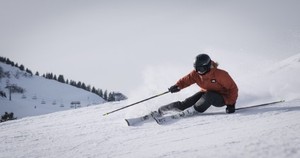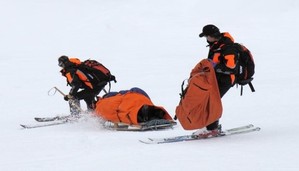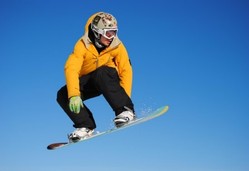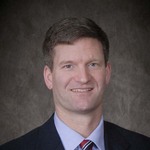12/14/2021
Skiing and Snowboarding Injuries
By Dr. Gavin Webb, Wentworth Health Partners Seacoast Orthopedics & Sports Medicine
As winter quickly approaches in New England, many of us eagerly await the first big dump of the season. In addition to doing some snow dances, there are other activities that can be done to help prepare for the physical demands that these sports place on our bodies. Proper conditioning, the use of suitable equipment and knowledge can help prevent injuries.
addition to doing some snow dances, there are other activities that can be done to help prepare for the physical demands that these sports place on our bodies. Proper conditioning, the use of suitable equipment and knowledge can help prevent injuries.
Why do injuries occur with skiing and snowboarding?
Most injuries are the result of a traumatic event. These can include falls, collisions, or mishaps getting on or off the lift. Most accidents happen very quickly with little or no time to react. Injuries are more common at the end of the day when fatigue and poor judgment have set in. Common issues that increase the likelihood of injury include:
- Fatigue/lack of conditioning
- Faulty/improper equipment
- Skiing or riding above ability level
- Dehydration
- Skiing or riding out of boundaries/closed trails
What are the most common skiing and snowboarding injuries?
- Knee injuries including ACL and meniscus tears
- Leg fractures
- Shoulder dislocations and separations
- Clavicle, wrist, and forearm fractures
- Thumb ligament tears
- Spinal and head injuries
How are skiing/snowboarding injuries treated?
Most mountain resorts have onsite first aid stations that will evaluate injured guests. Many of the injuries are minor sprains/strains/contusions and respond to rest, ice, anti-inflammatory medications and bracing with a relatively quick recovery. However, more significant injuries may require evaluation in an Emergency Room or follow up with the appropriate sports medicine provider and in some cases may require surgery with a longer recovery period.
minor sprains/strains/contusions and respond to rest, ice, anti-inflammatory medications and bracing with a relatively quick recovery. However, more significant injuries may require evaluation in an Emergency Room or follow up with the appropriate sports medicine provider and in some cases may require surgery with a longer recovery period.
Knee injuries
Initial treatment may include being placed on crutches and the use of a brace. Evaluation involves x-rays to rule out a fracture and often an MRI to visualize the soft tissues. MCL sprains typically heal with protection from a brace. ACL tears usually require surgery to reconstruct the ligament and a 6-9 month recovery. Meniscus tears likely require surgery to repair or remove the torn part of meniscus.
Leg fractures
Many leg fractures can be treated with a cast but may require non-weightbearing with the use of crutches. Some types of fractures require surgery to either repair the break with a plate and screws or with a rod placed inside the bone. X-rays are usually adequate to evaluate the fracture and determine which treatment is required.
Shoulder injuries
Injuries to the shoulder are initially evaluated with an exam and x-rays. Shoulder dislocations in which the ball slips out of the socket are treated emergently to replace the ball into the socket. This can sometimes be done at the mountain, but may require a trip to the emergency room. Depending on how the shoulder recovers, this injury may require surgery to repair a labral tear to restore stability. Shoulder separations, on the other hand, do not need to be put back into place and usually do not require surgery. These are treated initially in a sling followed by physical therapy.
Arm fractures
Fractures of the collarbone, wrist or forearm are initially evaluated by xrays. When the bones are out of alignment, they may need to be “reduced” or “set” and then casted. Some fractures require surgery to restore and maintain alignment with plates and screws.
Thumb ligament tears
“Skier’s thumb” can occur when skiers land on their hand while holding onto a pole. The ulnar collateral ligament (UCL) is torn and makes the base of the thumb unstable. This injury can usually be diagnosed with an exam and x-rays. Partial tears can be treated in a splint or cast, but complete tears usually require surgery.
Spinal and head injuries
These can be some of the most serious injuries sustained on the slopes. Ski patrol usually stabilizes potential head or spine injuries for transport to the emergency room for further evaluation and treatment. The use of helmets significantly reduces the potential for head or facial injuries.
Know the Code
National Ski Areas Association Responsibility Code
- Always stay in control.
- People ahead of you have the right-of-way.
- Stop in a safe place for you and others.
- Whenever starting downhill or merging, look uphill and yield.
- Use devices to help prevent runaway equipment.
- Observe signs and warnings, and keep off closed trails.
- Know how to use the lifts safely.
 Gavin Webb, MD has been a team physician for the University of New Hampshire Wildcats since moving to the Seacoast in 2005. He is board certified in both Orthopedic Surgery and Sports Medicine. An athlete himself, he provides care for patients throughout the entire age range and competitive levels from recreational to professional athlete. He specializes in arthroscopic and minimally invasive treatment of shoulder and knee conditions and has a special interest in treatment of cartilage injuries in the knee. He has been skiing all his life and also snowboards. He has officiated and provided medical coverage for youth and collegiate alpine ski racing.
Gavin Webb, MD has been a team physician for the University of New Hampshire Wildcats since moving to the Seacoast in 2005. He is board certified in both Orthopedic Surgery and Sports Medicine. An athlete himself, he provides care for patients throughout the entire age range and competitive levels from recreational to professional athlete. He specializes in arthroscopic and minimally invasive treatment of shoulder and knee conditions and has a special interest in treatment of cartilage injuries in the knee. He has been skiing all his life and also snowboards. He has officiated and provided medical coverage for youth and collegiate alpine ski racing.